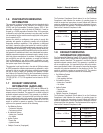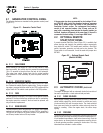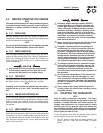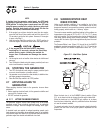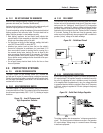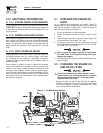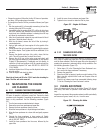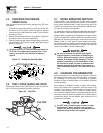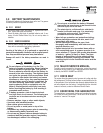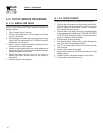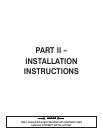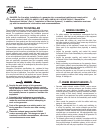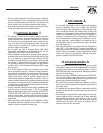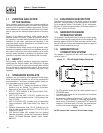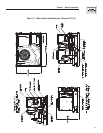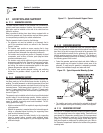
15
3.9 BATTERY MAINTENANCE
All lead-acid batteries will discharge when not in use. The genera-
tor battery should be inspected as follows:
3.9.1 WEEKLY
Inspect the battery posts and cables for tightness and corro-•
sion. Tighten and clean as necessary.
Check the battery fluid level of unsealed batteries and, if nec-•
essary, fill with Distilled Water Only. Do not use tap water in
batteries.
3.9.2 EVERY SIX MONTHS
Have the state of charge and condition checked. This should be •
done with an automotive-type battery hydrometer.
NOTE:
Servicing of the battery is to be performed or supervised by
personnel knowledgeable of batteries and the required precau-
tions. Keep unauthorized personnel away from batteries.
Damage will result if the battery connections are made in
reverse.
DANGER
Do not dispose of the battery in a fire. The
battery is capable of exploding. Stored batteries
give off explosive hydrogen gas. This gas can
form an explosive mixture around the battery for
several hours after charging. The slightest spark
can ignite the gas and cause an explosion. Such
an explosion can shatter the battery and cause
blindness or other injury. Any area that houses a
storage battery must be properly ventilated. Do
not allow smoking, open flame, sparks, or any
spark producing tools or equipment near the
battery. Discharge static electricity from body
before touching the battery by first touching a
grounded metal surface.
A battery presents a risk of electrical shock
and high short circuit current. The following pre-
cautions are to be observed when working on
batteries:
• Remove watches, rings or other metal objects;
• Use tools with insulated handles;
• Wear rubber gloves and boots;
• Do not lay tools or metal parts on top of the
battery;
• Disconnect any charging source prior to connecting
or disconnecting battery terminals; and
• Do not use any jumper cables or booster battery to
crank and start the generator engine. If any battery
has discharged, remove it for recharging.
Do not open or mutilate the battery. Released
electrolyte has been known to be harmful to the
skin and eyes, and to be toxic.
The electrolyte is a dilute sulfuric acid that is
harmful to the skin and eyes. It is electrically
conductive and corrosive. The following
procedures are to be observed:
• Wear full eye protection and protective clothing;
• Where electrolyte contacts the skin, wash it off
immediately with water;
• Where electrolyte contacts the eyes, flush
thoroughly and immediately with water and seek
medical attention; and
• Spilled electrolyte is to be washed down with an
acid neutralizing agent. A common practice is to
use a solution of 1 pound (500 grams) bicarbonate
of soda to 1 gallon (4 liters) or water. The bicar-
bonate of soda solution is to be added until the
evidence of reaction (foaming) has ceased. The
resulting liquid is to be flushed with water and the
area dried.
3.10 MAJOR SERVICE MANUAL
To obtain a service manual for the generator, contact the nearest
Authorized Service Dealer or, go to www.generac.com. Make sure
to identify the MODEL NUMBER and SERIES.
3.11 DRIVE BELT
The engine drives the generator rotor by means of a pulley and drive
belt arrangement. The drive belt and pulleys are warranted for the life
of the generator. Drive belt tension was properly adjusted before the
unit was shipped from the factory. If suspecting that the drive belt
tension is incorrect, contact an Authorized Service Dealer.
3.12 EXERCISING THE GENERATOR
The manufacturer recommends starting and operating the genera-
tor at least once every seven days. Let the unit run for at least 30
minutes to “exercise” the engine.
Section 3 – Maintenance
Recreational Vehicle Generator



